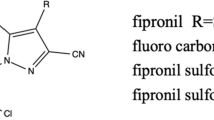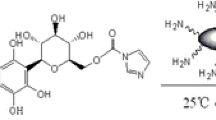Abstract
2-amino-3-methylimidazo [4, 5-f] quinoline (IQ), is a type of heterocyclic aromatic amines (HAAs) formed during the thermal treatment of food processing, which possesses potential carcinogenicity and mutagenicity for humans. In this work, a simple, selective and sensitive direct competitive enzyme-linked immunosorbent assay (dcELISA) for detecting IQ has been developed for the first time. 1H-pyrrolo [2, 3-f] quinoline (PQ), a structural analogue of IQ, was connected with two-carbon arm to obtain the hapten PQ acid (PQA), and then a specific polyclonal antibody was produced with PQA-bovine serum albumin (BSA) as immunogen. The half-maximum inhibition concentration (IC50) and limit of detection (LOD; calculated as IC15 value) of the assay were 50 ± 3 and 3 ± 0.3 μg L−1, respectively. The assay showed no cross-reactivity with other HAAs analogues except 2-amino-3,4-dimethylimidazo [4,5-f] quinoline (MeIQ) (12 %), which indicated that the assay had high specificity for the IQ. The proposed method was further applied successfully to determine IQ in fried beef, fried pork, and dried fish floss samples with satisfactory recoveries (84.96–116.23 %) and precision (CV%, 4.96–17.26 %). The LOD for IQ in processed foods was 15 μg kg−1. In addition, the results of the established method were in good agreement with the high-performance liquid chromatography (HPLC) (R 2 = 0.9917). All above shows the proposed immunoassay allows for a cost-effective, specific, accurate, and reliable quantitative detection of IQ in real processed food samples.





Similar content being viewed by others
References
Aga DS, Thurman EM (1997) Immunochemical technology for environmental applications. American Chemical Society, Washington
Balogh Z, Gray JI, Gomaa EA, Booren AM (2000) Formation and inhibition of heterocyclic aromatic amines in fried ground beef patties. Food Chem Toxicol 38(5):395–401. doi:10.1016/s0278-6915(00)00010-7
Bång J, Nukaya H, Skog K (2002) Blue Chitin columns for the extraction of heterocyclic amines from cooked meat. J Chromatogr A 977(1):97–105. doi:10.1016/s0021-9673(02)01351-1
Barceló-Barrachina E, Moyano E, Galceran MT, Lliberia JL, Bagó B, Cortes MA (2006) Ultra-performance liquid chromatography-tandem mass spectrometry for the analysis of heterocyclic amines in food. J Chromatogr A 1125:195–203. doi:10.1016/j.chroma.2006.05.060
Cárdenes L, Ayala JH, Afonso AM, González V (2004) Solid-phase microextraction coupled with high-performance liquid chromatography for the analysis of heterocyclic aromatic amines. J Chromatogr A 1030(1–2):87–93. doi:10.1016/j.chroma.2003.10.040
Cui JL, Zhang K, Huang QX, Yu YY, Peng XZ (2011) An indirect competitive enzyme-linked immunosorbent assay for determination of norfloxacin in waters using a specific polyclonal antibody. Anal Chim Acta 688(1):84–89. doi:10.1016/j.aca.2010.12.030
Fang GZ, Lv YY, Sheng W, Liu B, Wang XX, Wang S (2011) Development of an enzyme-linked immunosorbent assay for the determination of 5-hydroxymethyl-2-furfural in food. Anal Bioanal Chem 401(10):3367–3373. doi:10.1007/s00216-011-5430-4
Gross GA, Grüter A, Heyland S (1992) Optimization of the sensitivity of high-performance liquid chromatography in the detection of heterocyclic aromatic amine mutagens. Food Chem Toxicol 30(6):491–498. doi:10.1016/0278-6915(92)90100-y
Jägerstad M, Skog K, Grivas S, Olsson K (1991) Formation of heterocyclic amines using model systems. Mutat Res 259(3–4):219–233
Janoszka B, Blaszczyk U, Warzecha L, Strózyk M, Damasiewicz-Bodzek A, Bodzek D (2001) Clean-up procedures for the analysis of heterocyclic aromatic amines (aminoazaarenes) from heat-treated meat samples. J Chromatogr A 938(1–2):155–165. doi:10.1016/s0021-9673(01)01364-4
Kataoka H, Kijima K (1997) Analysis of heterocyclic amines as their N-dimethylaminomethylene derivatives by gas chromatography with nitrogen-phosphorus selective detection. J Chromatogr A 767(1–2):187–194. doi:10.1016/S0021-9673(96)01089-8
Mardones C, Arce L, Ríos A, Valcárcel M (1998) Determination of heterocyclic aromatic amines in fried beefsteak, meat extract, and fish by capillary zone electrophoresis. Chromatographia 48(9–10):700–706. doi:10.1007/bf02467602
Minako N, Takashi S (2000) Food borne carcinogens: heterocyclic amines. John Wiley & Sons Ltd
Özdestan Ö, Kaçar E, Keşkekoğlu H, Üren A (2014) Development of a new extraction method for heterocyclic aromatic amines determination in cooked meatballs. Food Anal Methods 7:116–126. doi:10.1007/s12161-013-9607-7
Richling E, Kleinschnitz M, Schreier P (1999) Analysis of heterocyclic aromatic amines by high resolution gas chromatography–mass spectrometry: a suitable technique for the routine control of food and process flavours. Eur Food Res Technol 210:68–72. doi:10.1007/s002170050535
Sanz Alaejos M, Ayala JH, González V, Afonso AM (2008) Analytical methods applied to the determination of heterocyclic aromatic amines in foods. J Chromatogr B 862(1–2):15–42. doi:10.1016/j.jchromb.2007.11.040
Skog KI, Johansson MAE, Jägerstad MI (1998) Carcinogenic heterocyclic amines in model systems and cooked foods: a review on formation, occurrence and intake. Food Chem Toxicol 36(9–10):879–896. doi:10.1016/s0278-6915(98)00061-1
Snyderwine EG, Turesky RJ, Turteltaub KW, Davis CD, Sadrieh N, Schut HA, Nagao M, Sugimura T, Thorgeirsson UP, Adamson RH, Thorgeirsson SS (1997) Metabolism of food-derived heterocyclic amines in nonhuman primates. Mutat Res 376(1–2):203–210. doi:10.1016/s0027-5107(97)00044-4
Sugimura T (1988) New environmental carcinogens in daily life. Trends Pharmacol Sci 9(6):205–209. doi:10.1016/0165-6147(88)90086-7
Toribio F, Moyano E, Puignou L, Galceran MT (2002) Ion-trap tandem mass spectrometry for the determination of heterocyclic amines in food. J Chromatogr A 948(1–2):267–281. doi:10.1016/s0021-9673(01)01476-5
Vollenbroker M, Eichner K (2000) A new quick solid-phase extraction method for the quantification of heterocyclic aromatic amines. Eur Food Res Technol 212(1):122–125. doi:10.1007/s002170000188
Wang S, Wang Y, Huang W, Fang GZ, Duan ZJ, Qiao H, Zhang Y (2007) Development of a solid-phase extraction-enzyme-linked immunosorbent assay method with a new sorbent of multiwall carbon nanotube for the determination of estrone in water. Anal Lett 40(12):2338–2350. doi:10.1080/00032710701577559
Wu J, Wong MK, Lee HK, Lee BL, Shi CY, Ong CN (1996) Determination of heterocyclic amines in flame-grilled fish patty by capillary electrophoresis. Food Addit Contam 13(7):851–861. doi:10.1080/02652039609374472
Zhang F, Chu XG, Sun L, Zhao YS, Ling Y, Wang XJ, Yong W, Yang ML, Li XQ (2008) Determination of trace food-derived hazardous compounds in Chinese cooked foods using solid-phase extraction and gas chromatography coupled to triple quadrupole mass spectrometry. J Chromatogr A 1209:220–229. doi:10.1016/j.chroma.2008.09.012
Zhang Y, Lin CP, Fang GZ, Mei JB, Wang X, Wang S (2012) Tandem solid phase extraction coupled to LC-ESI-MS/MS for the accurate simultaneous determination of five heterocyclic aromatic amines in processed meat products. Eur Food Res Technol 234:197–205. doi:10.1007/s00217-011-1624-4
Zhao CB, Liu W, Ling HL, Lu SX, Zhang YL, Liu JT, Xi RM (2007) Preparation of anti-gatifloxacin antibody and development of an indirect competitive enzyme-linked immunosorbent assay for the detection of gatifloxacin residue in milk. J Agric Food Chem 55(17):6879–6884. doi:10.1021/jf070978g
Compliance with Ethical Standards
ᅟ
Funding
The authors are grateful for financial supports from the Ministry of Science and Technology of the People’s Republic of China (Project no. 2011AA100806), the National Natural Science Foundation of China (Project no. 31201353), Tianjin Municipal Science and Technology Commission (Project no. 13JCQNJC15300), and International Science and Technology Cooperation Program of China (Project no. 2014DFR30350).
Conflict of Interest
Wei Sheng declares that she has no conflict of interest. Xuqin Ran declares that she has no conflict of interest. Gaoshuang Hu declares that she has no conflict of interest. Yan Zhang declares that she has no conflict of interest. Yang Lu declares that she has no conflict of interest. Bing Liu declares that she has no conflict of interest. Shuo Wang declares that he has no conflict of interest.
Ethical Approval
All applicable international, national , and institutional guidelines for the care and use of laboratory animals were followed. This article does not contain any studies with human participants performed by any of the authors.
Informed Consent
Not applicable.
Author information
Authors and Affiliations
Corresponding author
Rights and permissions
About this article
Cite this article
Sheng, W., Ran, X., Hu, G. et al. Development of an Enzyme-Linked Immunosorbent Assay for the Detection of 2-Amino-3-Methylimidazo [4, 5-f] Quinoline (IQ) in Processed Foods. Food Anal. Methods 9, 1036–1045 (2016). https://doi.org/10.1007/s12161-015-0282-8
Received:
Accepted:
Published:
Issue Date:
DOI: https://doi.org/10.1007/s12161-015-0282-8




